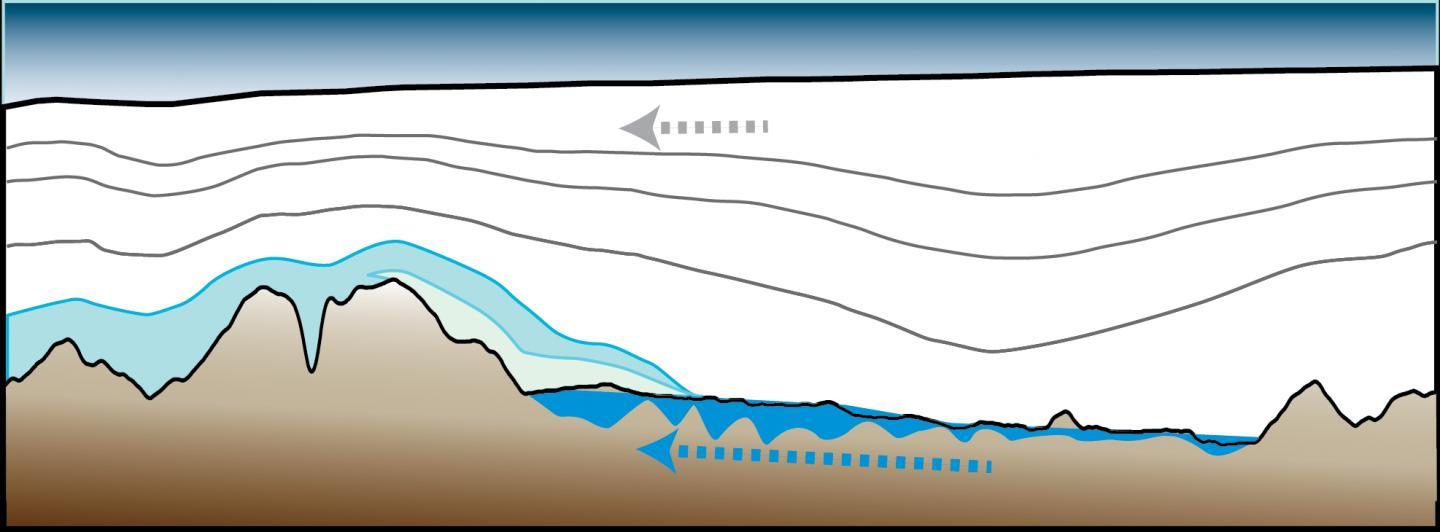Time is relative. What is a long time to humans is nothing to a mountain. Like humans, mountains usually burst on the scene, then they stand tall and finally age wears them down and their sharp features soften and they become grow shorter and rounder.
Not all mountains, though. The Gamburtsev Mountains in the middle of Antarctica look quite young for their age. Though the Gamburtsevs were discovered in the 1950s, they remained unexplored until government budget increases and few things left above ground to explore led scientists to fly ice-penetrating instruments over the mountains 60 years later.
The images revealed mountains that should have looked hundreds of millions of years older than they did, but instead had the saw-toothed and towering crags of much younger mountains. Instead of looking like their contemporaries, the largely worn-down Appalachians, they looked more like the Rockies, which are nearly 200 million years younger.

Images of the ice-covered Gamburtsev Mountains revealed water-filled valleys, as seen by the cluster of vertical lines in this image. Credit: Tim Creyts
What accounts for it? The scientists believe it is a vast network of lakes and rivers at the mountains' base. Water is usually the enemy of mountains, it speeds erosion, but there it seems to have kept erosion at bay, in the form of thick ice that has entombed the Gamburtsevs since Antarctica went into a deep freeze 35 million years ago.
"The ice sheet acts like an anti-aging cream," said the study's lead author, Timothy Creyts, a geophysicist at Columbia University's Lamont-Doherty Earth Observatory. "It triggers a series of thermodynamic processes that have almost perfectly preserved the Gamburtsevs since ice began spreading across the continent."
The study explains how the blanket of ice covering the Gamburtsevs has preserved its rugged ridgelines.
Snow falling at the surface of the ice sheet draws colder temperatures down, closer to protruding peaks in a process called divergent cooling. At the same time, heat radiating from bedrock beneath the ice sheet melts ice in the deep valleys to form rivers and lakes. As rivers course along the base of the ice sheet, high pressures from the overlying ice sheet push water up valleys in reverse. This uphill flow refreezes as it meets colder temperature from above. Thus, ridgelines are cryogenically preserved.

Scientists hypothesize that cold temperatures and high pressures push the water uphill, in the same direction as overlying ice flows. This causes ridgelines to refreeze, thus warding off erosion. Credit: Tim Creyts
The oldest rocks in the Gamburtsevs formed more than a billion years ago, in the collision of several continents. Though these prototype mountains eroded away, a lingering crustal root became reactivated when the supercontinent Gondwana ripped apart, starting about 200 million years ago. Tectonic forces pushed the land up again to form the modern Gamburtsevs, which range across an area the size of the Alps. Erosion again chewed away at the mountains until earth entered a cooling phase 35 million years ago.
Expanding outward from the Gamburtsevs, a growing layer of ice joined several other nucleation points to cover the entire continent in ice.
The researchers say that the mechanism that stalled aging of the Gamburtsevs at higher elevations may explain why some ridgelines in the Torngat Mountains on Canada's Labrador Peninsula and the Scandinavian Mountains running through Norway, Sweden and Finland appear strikingly untouched. Massive ice sheets covered both landscapes during the last ice age, which peaked about 20,000 years ago, but many high-altitude features bear little trace of this event.
"The authors identify a mechanism whereby larger parts of mountains ranges in glaciated regions--not just Antarctica--could be spared from erosion," said Stewart Jamieson, a glaciologist at Durham University who was not involved in the study. "This is important because these uplands are nucleation centers for ice sheets. If they were to gradually erode during glacial cycles, they would become less effective as nucleation points during later ice ages."
Ice sheet behavior, then, may influence climate change in ways that scientists and computer models have yet to appreciate. As study coauthor Fausto Ferraccioli, head of the British Antarctic Survey's airborne geophysics group, put it: "If these mountains in interior East Antarctica had been more significantly eroded then the ice sheet itself
may have had a different history."





Comments